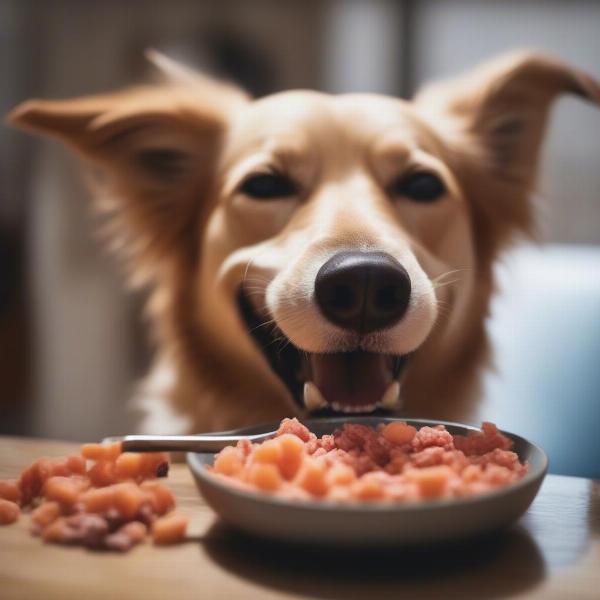Raw dog food delivery services are becoming increasingly popular, offering a convenient way to provide your furry friend with a nutritionally balanced, species-appropriate diet. But with so many options available, how do you choose the best raw dog food delivered right to your doorstep? This article will explore the benefits of raw feeding, factors to consider when choosing a delivery service, and tips for transitioning your dog to a raw diet.
Understanding the Benefits of Raw Dog Food
Many dog owners are turning to raw food as a way to mimic the natural diet of their canine ancestors. A raw diet typically consists of muscle meat, organ meat, bones, and sometimes fruits and vegetables. Advocates of raw feeding claim it can lead to several health benefits, including:
- Improved digestion: Raw food is often easier for dogs to digest than processed kibble.
- Shinier coat and healthier skin: The high-quality protein and essential fatty acids in raw food can contribute to a healthier coat and skin.
- Increased energy levels: Many owners report increased energy levels in their dogs after switching to a raw diet.
- Better dental health: Chewing on raw bones can help to clean teeth and prevent tartar buildup.
However, it’s crucial to remember that raw feeding also carries potential risks, such as bacterial contamination. Proper handling and storage are essential to minimize these risks. Always consult with your veterinarian before transitioning your dog to a raw food diet.
Choosing the Right Raw Dog Food Delivery Service
Selecting a reputable raw dog food delivery service is paramount. Consider the following factors:
- Ingredient quality: Look for services that use high-quality, human-grade ingredients sourced from reputable suppliers.
- Nutritional balance: Ensure the raw food is complete and balanced, meeting AAFCO (Association of American Feed Control Officials) guidelines for dogs.
- Variety: A good service should offer a variety of protein sources and recipes to cater to your dog’s individual needs and preferences.
- Customization: Some services allow you to customize meal plans based on your dog’s breed, age, activity level, and any allergies or sensitivities.
- Delivery options: Consider how frequently you want deliveries and whether the service delivers to your area.
- Packaging and storage: Ensure the food is packaged and shipped safely to maintain its freshness.
Transitioning Your Dog to Raw Food
Switching your dog to a raw food diet should be done gradually to avoid digestive upset. Start by introducing small amounts of raw food alongside their current diet, slowly increasing the proportion of raw food over several days or weeks. Monitor your dog closely for any signs of digestive issues, such as vomiting or diarrhea.
 Dog Eating Raw Food
Dog Eating Raw Food
Is Raw Dog Food Delivered More Expensive?
While often perceived as pricier than kibble, the long-term benefits of raw dog food, such as improved health and reduced vet bills, can sometimes offset the initial cost. Explore dog food subscription options for potential cost savings.
How to Store Delivered Raw Dog Food?
Proper storage is critical for raw dog food. Freeze any unused portions immediately upon delivery and thaw only what you need for each meal. More information on raw food storage can be found in our lyka dog food review.
Conclusion
Raw dog food delivered to your door offers a convenient and potentially beneficial way to nourish your canine companion. By carefully researching different providers, such as comparing different dog vs butternut box, and choosing a service that prioritizes ingredient quality, nutritional balance, and safe handling practices, you can provide your dog with a healthy and delicious raw diet. Remember to consult with your veterinarian before making any dietary changes and always prioritize safe handling and storage of raw dog food.
FAQ
- Can puppies eat raw dog food? Yes, puppies can eat raw food, but it’s essential to ensure the diet is specifically formulated for their growing needs. Consult with your veterinarian for guidance.
- What are the signs of foodborne illness in dogs? Signs of foodborne illness can include vomiting, diarrhea, lethargy, fever, and loss of appetite.
- How long can I store raw dog food in the freezer? Raw dog food can typically be stored in the freezer for up to six months.
- Do I need to supplement a raw diet? While a complete and balanced raw food diet shouldn’t require supplementation, it’s always best to discuss supplementation with your veterinarian.
- Where can I find raw dog food delivered near me? Searching online for “raw dog food delivery near me” or “raw dog food leicester” if you are in Leicester, can help you locate local providers.
- Is a raw diet suitable for all dog breeds? Most dog breeds can thrive on a raw diet; however, consult your vet to ensure it’s appropriate for your dog’s specific health needs.
- What if my dog doesn’t like raw food at first? Transitioning slowly and trying different protein sources can help encourage your dog to accept raw food. delivery raw dog food services often offer variety packs to help with this.
ILM Dog is your trusted resource for expert advice and information on all aspects of dog care, from breed selection and puppy care to senior dog care and travel tips. We are passionate about providing dog owners with the knowledge and resources they need to ensure their furry friends live long, healthy, and happy lives. Our expertise extends to nutrition and feeding, offering insights into various dietary options, including raw food diets. Contact us at [email protected] or +44 20-3965-8624 for personalized advice or explore our comprehensive resources on ILM Dog.